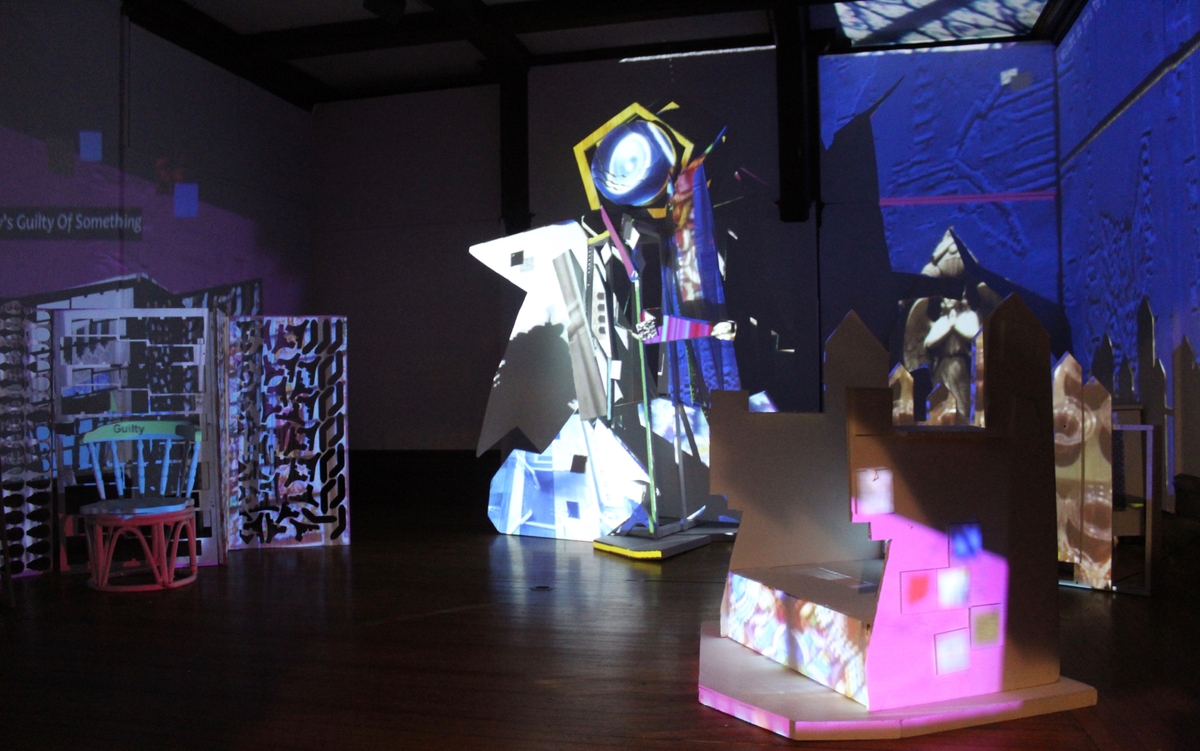
A darkened room filled with luminous yet ruinous shapes. A wavering eye at the top of a crooked tower, never blinking but always bleary. One wall has been transformed into a pale blue screen. The words “I wouldn’t do this to you if you didn’t deserve it” are typed out in a primitive font. Across the room is a chair with the word “guilty” projected onto it; on the wall behind it, a more expansive message: “Everybody’s guilty of something.”
The gallery is one of four in the Ely Center of Contemporary Art given over to “Technically Real,” a group show by 22 visual arts students at Educational Center for the Arts running now through Dec. 19 that speaks with a loud, buzzing, and ultimately quite cohesive voice about what it has been like to be a young adult in a time unlike any other than Americans have quite experienced — what the upheaval has revealed, and in a broader sense, where we should and shouldn’t go from here.
Viewers looking to get their bearings in the sprawling show might start in the gallery to the left of the main entrance. Amid the gallery’s noisy video collage, the main features of the projections in that room are the people running and jumping in place, as if on a fast treadmill, or as if proceeding through a difficult, invisible obstacle course. They stumble and vanish, then do it all again, over and over, as if trapped in a bad video game. They’re all wearing pandemic face masks.

In the next room is a bank of monitors with the same sense of disjointed repetitiveness, here sprinkled with a little claustrophobia. An image of a fly trapped in mesh blinks in and out again. On another screen, we hear about a boy who has accidently let go of his red balloon. As it floats into the sky, the narrator declares it lost, “forevermore,” a bit of melodrama that’s sincere in its feelings but sharp-eyed and sarcastic about what to do about it.
In the two galleries, it’s hard not to see the assaultive echoes of daily life outside of the gallery — the way teenagers in the past two years have been sent to schools that then close, stuck at home, brought back to school to wear masks all day, only to see them still close, again and again. While adults talk about getting “back to normal,” for teenagers, disruption is the new normal. And that disruption comes from all corners — if it’s not the pandemic, it’s social unrest. If it’s not social unrest, it’s the threat of violence, and in some cases actual violence, at school. It’s a set of obstacles with no real end in sight, a game that can’t be won.
That mindset offers context for the gallery with that bleary, unblinking eye. There are elements of a few classic emblems of inescapable surveillance, whether you want to call it the Eye of Sauron or Jeremy Bentham’s Panopticon. But in this exhibit, the symbols of authority are seriously glitchy, full of bugs. The question of how much control they want to exert is followed immediately by how much they really can. Can we trust this authority to do the right thing? Can we trust that it’s able to?

The final gallery is both eerie and peaceful. It completes the general sense that the ECA students have turned the first floor of the Ely Center into a kind of haunted house, while also reflecting the sense of a society in a seriously dilapidated state, covered in plastic cobwebs, wan lights illuminating a structure on the brink of teetering over. It’s sad, angry, strange, and comical all at once.
If we want to think of it as a commentary on the state of the world as this group of young artists see it, it offers no answers. But it’s also a strong corrective to the easy answers adults have given themselves in response to the chaos we’ve faced. The current administration talks about restoring normal government activities when a large number of people no longer accept the legitimacy of elections. We all talk about getting back to a normal that has now been gone for almost two years. Is it really possible to go back? And it’s fair for the generation coming up to ask what normal it is we want to return to. The one that turned a blind eye to police brutality against Black people? The one that’s still moving us steadily toward a climate crisis that today’s teenagers will bear the brunt of as adults?
An art exhibit can’t offer real answers to these questions. But the message seems clear enough; if we understand better how younger people see the world we’re handing them, perhaps we can figure out those answers together with them. And also: how long do we really have to wait before they can vote?
“Technically Real” runs through Dec. 19 at the Ely Center of Contemporary Art, 51 Trumbull St. Visit ECOCA’s website for hours and more information. The ECA artists involved in the exhibit are Shiloh Aceto, Max Barrett, Jillian Beardsley, Maia Coto, Madeleine Garley-Erb, AJ Giovanni, Sophie Greber, Ari Hurwitz, Eleanor Law, Julia Mann, Chloe Massicotte, Jaclyn Mauri, John Carlos Serana Musser, Claire Osiecki, Abigail Rossi, Ryan Rugarema, Nolan Serra, Maja Shallow, Quinn Shane, Henry Slomba, Ila Sundstrom, and Noemi Szolnay.